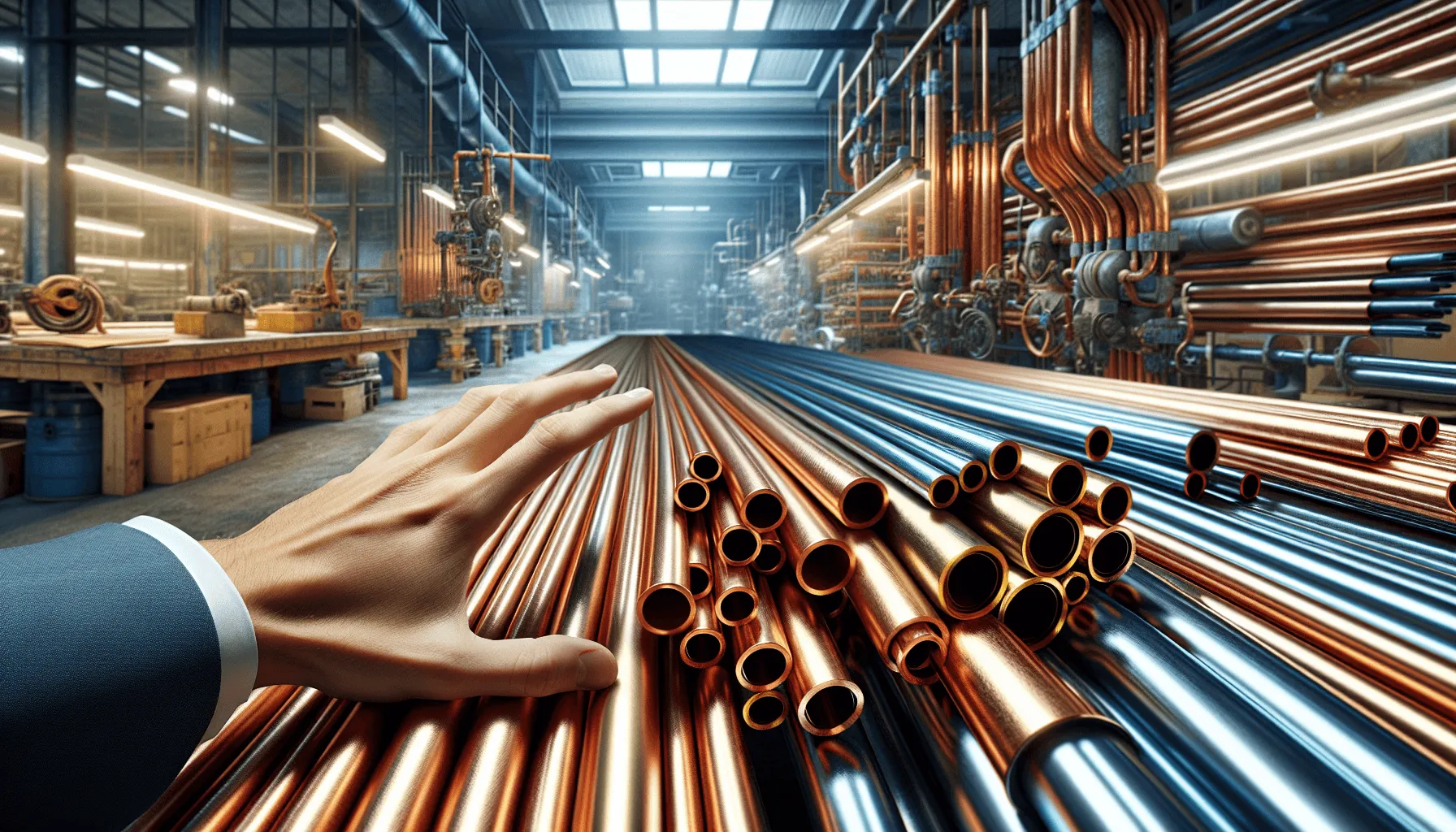When it comes to selecting plumbing materials for your home, the choice often narrows down to copper vs galvanized pipe. Each material has distinct properties that can significantly impact the performance and longevity of your plumbing system.
In this article, we’ll cover:
- The differences between copper and galvanized pipes.
- The advantages and disadvantages of each type.
- Key factors like durability, health considerations, installation costs, and performance under various conditions.
Understanding these aspects will help you make an informed decision tailored to your plumbing needs.
Understanding Copper Pipes
Copper pipes are a popular choice in plumbing due to their durability and versatility. There are four main types of copper pipes, each serving different purposes:
- Type K Copper Pipe: The heaviest and thickest, ideal for underground installations.
- Type L Copper Pipe: Slightly thinner than Type K, commonly used for interior water supply lines.
- Type M Copper Pipe: Thinner walls, suitable for light plumbing applications where pressure is lower.
- DWV Copper Pipe: Designed for drainage, waste, and vent systems rather than water supply.
Key advantages of using copper pipes in plumbing include:
- Corrosion Resistance: Copper naturally resists corrosion, which ensures a longer lifespan compared to other materials.
- Heat Conductivity: Excellent heat conductivity makes copper ideal for hot water systems.
- Microbial Growth Inhibition: Copper’s properties inhibit bacterial growth, promoting a cleaner water supply.
- No Lead Content: Safe for drinking water as it doesn’t leach harmful substances into the water.
These benefits make copper a reliable and preferred material for various plumbing applications.
Understanding Galvanized Pipes
Galvanized pipes are steel pipes coated with a layer of zinc to prevent rust and corrosion. This zinc coating acts as a barrier, protecting the steel from moisture and environmental elements that could cause rust.
Definition and Composition
- Material: Steel
- Coating: Zinc
The zinc coating is applied through a process known as galvanization, which involves dipping the steel pipes into molten zinc. This coating helps extend the lifespan of the pipes by shielding them from rust and corrosion, but it can wear off over time, leading to potential issues.
Historical Context
Galvanized pipes were predominantly used in homes built before the 1960s. During this period, they were considered a superior option due to their initial resistance to corrosion compared to bare steel or iron pipes.
Key Points:
- Common in homes built pre-1960s.
- Replaced older materials like lead or iron due to better rust resistance.
Despite their early popularity, galvanized pipes have several drawbacks that have led to their decline in use. As the zinc coating wears down, these pipes become susceptible to corrosion and rust buildup internally, which can affect water quality and flow.
Durability and Longevity Comparison
When deciding between copper and galvanized pipes, how long plumbing pipes last is a crucial factor. Copper pipes generally have a significant advantage in terms of lifespan. On average, copper pipes can last anywhere from 50 to 70 years, and in some cases, even longer. This makes them a durable choice for long-term plumbing solutions.
In contrast, galvanized pipes typically have a shorter lifespan. These pipes usually last around 40 years but are susceptible to corrosion over time. As the zinc coating wears off, the steel underneath becomes prone to rust, which can lead to pipe deterioration and water quality issues.
Several factors affect the durability of these materials:
- Corrosion Resistance: Copper is naturally resistant to corrosion, which contributes to its long lifespan. It does not rust and maintains its integrity even when exposed to water for extended periods.
- Rust Buildup: Galvanized pipes suffer from rust buildup as the zinc coating erodes. This not only shortens their lifespan but also affects water quality.
- Environmental Conditions: Copper performs well in various environmental conditions and is less affected by temperature fluctuations compared to galvanized pipes, which can burst in freezing temperatures.
Understanding these differences helps you make informed decisions about the best plumbing materials for your home’s needs.
Health Considerations with Plumbing Materials

Galvanized pipes come with significant health risks. One major concern is rust buildup, which can cause water discoloration and affect its taste. Over time, the zinc coating inside galvanized pipes can erode, leading to rust formation. This rust not only impacts water quality but also poses potential health risks.
Another critical issue is lead contamination. Homes built before the 1960s often have galvanized pipes that may contain lead. As these pipes corrode, lead particles can leach into the water supply, posing serious health risks, especially for children and pregnant women.
Copper pipes offer several safety advantages for drinking water:
- Corrosion Resistance: Copper does not rust, ensuring a clean water supply.
- Lead-Free: Unlike galvanized pipes, copper pipes do not pose a risk of lead contamination.
- Antimicrobial Properties: Copper inhibits bacterial growth, further safeguarding your drinking water.
These factors make copper a safer choice for residential plumbing systems.
Installation Costs and Challenges in Plumbing Projects
When considering the cost of copper pipes versus galvanized pipes, it’s important to recognize the financial implications and installation challenges associated with each.
Installation Costs
- Copper Pipes: Generally, copper pipes are more expensive than galvanized pipes. This higher cost is due to the material itself and its market demand. On average, you might expect to pay between $2 to $4 per foot for copper piping.
- Galvanized Pipes: Typically cheaper, galvanized pipes cost around $1 to $2 per foot. However, these initial savings may be offset by higher maintenance costs over time due to corrosion issues.
Installation Challenges
Copper Pipes:
- Labor Intensity: Installing copper pipes requires soldering skills, which can be labor-intensive and time-consuming.
- Skill Required: Proper installation demands expertise in handling copper piping tools and techniques, ensuring leak-free joints.
Galvanized Pipes:
- Labor Intensity: Despite being simpler to install compared to copper, galvanized pipes are cumbersome, making installation physically demanding.
- Skill Required: Threading and cutting galvanized pipes require specialized tools and skills, to ensure proper fitting to avoid leaks.
While the initial cost of copper pipes is higher, their durability and lower maintenance requirements often justify the investment. Galvanized pipes might seem like a cost-effective choice initially but could lead to frequent repairs and replacements down the line. It’s essential to consider local plumbing regulations such as those outlined in the Kentucky Plumbing Law Regulations, which may influence your choice of materials and installation practices.
Performance Under Various Conditions: A Practical Perspective
Effects of Hard Water on Pipes
The hardness of water significantly impacts the performance of both copper and galvanized pipes. Hard water, rich in minerals like calcium and magnesium, can lead to scale buildup inside the pipes.
Galvanized Pipes
These are particularly vulnerable to hard water. The mineral deposits accumulate on the inner walls, reducing water flow over time. This buildup can exacerbate corrosion, leading to rust and potential leaks. It’s not uncommon for homes with galvanized pipes to experience reduced water pressure due to these obstructions.
Copper Pipes
Copper is more resistant to the adverse effects of hard water. While mineral buildup can still occur, it is less likely to cause significant blockages. Copper’s smooth interior surface helps minimize the scale accumulation, maintaining better water flow compared to galvanized pipes.
When considering copper vs galvanized pipe for your home, it’s essential to factor in local water conditions. In areas with hard water, copper pipes generally offer better long-term performance and reliability.
FAQs (Frequently Asked Questions)
What are the main differences between copper and galvanized pipes?
Copper pipes are known for their corrosion resistance and excellent heat conductivity, while galvanized pipes are coated with zinc to prevent rust but may pose health risks due to potential lead exposure. Understanding these differences can help you choose the best option for your plumbing needs.
What types of copper pipes are available?
There are three main types of copper pipes: Type K (thickest wall, used for underground applications), Type L (medium thickness, suitable for general plumbing), and Type M (thin wall, often used for residential water systems). Each type has its specific applications based on durability and pressure requirements.
How long do copper and galvanized pipes typically last?
Copper pipes can last over 50 years when properly maintained, while galvanized pipes usually have a lifespan of about 20 to 50 years depending on conditions like water quality and corrosion. Factors like the presence of hard water can significantly affect their longevity.
Are there health risks associated with using galvanized pipes?
Yes, galvanized pipes can pose health risks due to rust buildup and potential lead exposure from the zinc coating. In contrast, copper pipes are considered safer for drinking water as they do not carry the same risks.
What are the installation costs and challenges for copper vs. galvanized pipes?
Installation costs can vary; generally, copper pipes tend to be more expensive than galvanized ones. However, installing copper can be less labor-intensive due to its lighter weight and flexibility, while galvanized pipes may require more skilled labor due to their heavier weight and rigidity.
How does hard water affect the performance of copper and galvanized pipes?
Hard water can lead to mineral buildup in both types of pipes, but it tends to affect galvanized pipes more severely due to their tendency to corrode over time. Copper pipes generally handle hard water better but may still experience some scaling that could impact flow rates.


Comments are closed